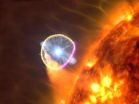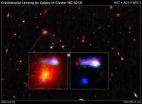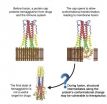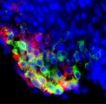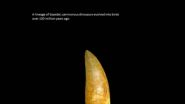(Press-News.org) Observations by NASA's Fermi Gamma-ray Space Telescope of several stellar eruptions, called novae, firmly establish these relatively common outbursts almost always produce gamma rays, the most energetic form of light.
"There's a saying that one is a fluke, two is a coincidence, and three is a class, and we're now at four novae and counting with Fermi," said Teddy Cheung, an astrophysicist at the Naval Research Laboratory in Washington, and the lead author of a paper reporting the findings in the Aug. 1 edition of the journal Science.
A nova is a sudden, short-lived brightening of an otherwise inconspicuous star caused by a thermonuclear explosion on the surface of a white dwarf, a compact star not much larger than Earth. Each nova explosion releases up to 100,000 times the annual energy output of our sun. Prior to Fermi, no one suspected these outbursts were capable of producing high-energy gamma rays, emission with energy levels millions of times greater than visible light and usually associated with far more powerful cosmic blasts.
Fermi's Large Area Telescope (LAT) scored its first nova detection, dubbed V407 Cygni, in March 2010. The outburst came from a rare type of star system in which a white dwarf interacts with a red giant, a star more than a hundred times the size of our sun. Other members of the same unusual class of stellar system have been observed "going nova" every few decades.
In 2012 and 2013, the LAT detected three so-called classical novae which occur in more common binaries where a white dwarf and a sun-like star orbit each other every few hours.
"We initially thought of V407 Cygni as a special case because the red giant's atmosphere is essentially leaking into space, producing a gaseous environment that interacts with the explosion's blast wave," said co-author Steven Shore, a professor of astrophysics at the University of Pisa in Italy. "But this can't explain more recent Fermi detections because none of those systems possess red giants."
Fermi detected the classical novae V339 Delphini in August 2013 and V1324 Scorpii in June 2012, following their discovery in visible light. In addition, on June 22, 2012, the LAT discovered a transient gamma-ray source about 20 degrees from the sun. More than a month later, when the sun had moved farther away, astronomers looking in visible light discovered a fading nova from V959 Monocerotis at the same position.
Astronomers estimate that between 20 and 50 novae occur each year in our galaxy. Most go undetected, their visible light obscured by intervening dust and their gamma rays dimmed by distance. All of the gamma-ray novae found so far lie between 9,000 and 15,000 light-years away, relatively nearby given the size of our galaxy.
Novae occur because a stream of gas flowing from the companion star piles up into a layer on the white dwarf's surface. Over time -- tens of thousands of years, in the case of classical novae, and several decades for a system like V407 Cygni -- this deepening layer reaches a flash point. Its hydrogen begins to undergo nuclear fusion, triggering a runaway reaction that detonates the accumulated gas. The white dwarf itself remains intact.
One explanation for the gamma-ray emission is that the blast creates multiple shock waves that expand into space at slightly different speeds. Faster shocks could interact with slower ones, accelerating particles to near the speed of light. These particles ultimately could produce gamma rays.
"This colliding-shock process must also have been at work in V407 Cygni, but there is no clear evidence for it," said co-author Pierre Jean, a professor of astrophysics at the University of Toulouse in France. This is likely because gamma rays emitted through this process were overwhelmed by those produced as the shock wave interacted with the red giant and its surroundings, the scientists conclude.
NASA's Fermi Gamma-ray Space Telescope is an astrophysics and particle physics partnership managed by the agency's Goddard Space Flight Center in Greenbelt, Maryland. It was developed in collaboration with the U.S. Department of Energy, with contributions from academic institutions and partners in France, Germany, Italy, Japan, Sweden and the United States.
INFORMATION:
For more information about Fermi, visit:
http://www.nasa.gov/fermi
NASA's Fermi space telescope reveals new source of gamma rays
2014-07-31
ELSE PRESS RELEASES FROM THIS DATE:
Study finds physical link to strange electronic behavior
2014-07-31
HOUSTON -- (July 31, 2014) -- Scientists have new clues this week about one of the baffling electronic properties of the iron-based high-temperature superconductor barium iron nickel arsenide. A Rice University-led team of U.S., German and Chinese physicists has published the first evidence, based on sophisticated neutron measurements, of a link between magnetic properties and the material's tendency, at sufficiently low temperatures, to become a better conductor of electricity in some directions than in others.
The odd behavior, which has been documented in a number ...
Hubble shows farthest lensing galaxy yields clues to early universe
2014-07-31
Astronomers using NASA's Hubble Space Telescope have unexpectedly discovered the most distant galaxy that acts as a cosmic magnifying glass. Seen here as it looked 9.6 billion years ago, this monster elliptical galaxy breaks the previous record-holder by 200 million years.
These "lensing" galaxies are so massive that their gravity bends, magnifies, and distorts light from objects behind it, a phenomenon called gravitational lensing. Finding one in such a small area of the sky is so rare that you would normally have to survey a region hundreds of times larger to find just ...
Researchers uncover clues to flu's mechanisms
2014-07-31
HOUSTON – (July 31, 2014) – A flu virus acts like a Trojan horse as it attacks and infects host cells. Scientists at Rice University and Baylor College of Medicine have acquired a clearer view of the well-hidden mechanism involved.
Their computer simulations may lead to new strategies to stop influenza, perhaps even a one-size-fits-all vaccine.
The discovery detailed this week in the Proceedings of the National Academy of Science shows the path taken by hemagglutinin, a glycoprotein that rides the surface of the influenza virus, as it releases fusion peptides to invade ...
UF study advances 'DNA revolution,' tells butterflies' evolutionary history
2014-07-31
GAINESVILLE, Fla. --- By tracing nearly 3,000 genes to the earliest common ancestor of butterflies and moths, University of Florida scientists have created an extensive "Tree of Lepidoptera" in the first study to use large-scale, next-generation DNA sequencing.
Among the study's more surprising findings: Butterflies are more closely related to small moths than to large ones, which completely changes scientists' understanding of how butterflies evolved. The study also found that some insects once classified as moths are actually butterflies, increasing the number of butterfly ...
NYU CDUHR researchers look at prescription opioid abuse among young adults in NYC
2014-07-31
The prevalence of heroin use has been rising steadily in the U.S in recent years. According to the National Survey on Drug Use and Health, the number of individuals reporting past year heroin use almost doubled between 2007 (373,000) and 2012 (669,000). Emerging evidence suggests the increase may be linked to prescription opioid (PO) users who transition from oral and/or intranasal PO use to heroin use, with POs providing the entryway to regular opioid use, and ultimately, heroin injection. This drug-use trajectory appears to have become increasingly common over the past ...
NYU research looks to combat US Latina immigrant obesity
2014-07-31
According to the U.S. Census Bureau, Latinos are the largest minority group in the United States, comprising 16.7% of the population. Approximately one-third of Latinos are obese and are 1.2 times as likely to be obese compared to non-Hispanic Whites.
NYU College of Nursing student researcher Lauren Gerchow, BSN, RN, MSN candidate, has sought to identify the factors that contribute to this problem by compiling a systematic review of qualitative studies that focused on food patterns in Latina women recently published in Nursing Research.
"The review focuses on women ...
Stanford professor finds that wildfires and other burns play bigger role in climate change
2014-07-31
It has long been known that biomass burning – burning forests to create agricultural lands, burning savannah as a ritual , slash-and-burn agriculture and wildfires – figures into both climate change and public health.
But until the release of a new study by Stanford University Civil and Environmental Engineering Professor Mark Z. Jacobson, the degree of that contribution had never been comprehensively quantified.
Jacobson's research, detailed in a paper published July 30 in the Journal of Geophysical Research: Atmospheres, is based on a three-dimensional computer model ...
Childhood coxsackie virus infection depletes cardiac stem cells and might compromise heart health in adults
2014-07-31
There is epidemiological evidence that links type B coxsackie virus (CVB) infection with heart disease, and research published on July 31st in PLOS Pathogens now suggests a mechanism by which early infection impairs the heart's ability to tolerate stress at later stages of life.
CVB infection is very common and affects mostly children. The symptoms range widely: over half of the infections are thought to be asymptomatic, the majority of children who get sick have only a mild fever, and a very small proportion get inflammation of the heart or brain. On the other hand, ...
Multidisciplinary study reveals big story of cultural migration
2014-07-31
Quantifying and transforming the history of culture into visual representation isn't easy. There are thousands of individual stories across millennia to consider, and some historical conditions are nearly impossible to measure.
Addressing this challenge, Dr. Maximilian Schich, associate professor of arts and technology at The University of Texas at Dallas, has brought together a team of network and complexity scientists to create and quantify a big picture of European and North American cultural history.
Schich, an art historian who works under the umbrella of the ...
Shrinking dinosaurs evolved into flying birds
2014-07-31
VIDEO:
This movie is an animated version of how birds arose from a very special lineage of evolving dinosaurs.
Click here for more information.
A new study involving scientists from the University of Southampton has revealed how massive, meat-eating, ground-dwelling dinosaurs evolved into agile flying birds: they just kept shrinking and shrinking, for over 50 million years.
Today, in the journal Science, the researchers present a detailed family tree of dinosaurs and their ...

